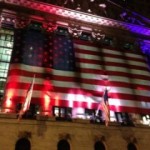NEW YORK — Power is finally returning to one of lower Manhattan’s worst hit areas: the Financial District.
Hurricane Sandy had effectively divided the city in two, the haves and the have nots.
Uptown New Yorkers had power and access to stocked grocery stories while downtown many people remained in the dark, their streets flooded without access to shops or restaurants with food or even working traffic lights.
Walk around the Financial District today and you’ll hear the hum of generators and water being pumped out of the lobbies of office buildings and restaurant entrances. Dirty streets are piling up with black garbage bags while relatively few people walk the normally crowded sidewalks.
ConEd trucks, industrial dumpsters and yellow crime scene tape are now the norm.
On streets once filled with cars, you can find the occasional taxi or bus. On Saturday, broken traffic lights blinked yellow or red.
In lower Manhattan, the areas most devastated by the storm were Battery Park City, South Street Seaport and Wall Street.
Matthew Conaty, 31, a lawyer who lives and works on Wall Street, was among the last few people to evacuate the area before the storm hit Monday evening.
“My building manager sent me an email that ConEd could cut the power at anytime within the next hour and I knew I’d lose light, heat but also water,” Conaty said. “The city was starting to close the bridges and tunnels to leave Manhattan. I realized the elevator power was out and it was in my best interest to walk down the 21 flights of stairs to the lobby and leave as quickly as possible.”
Conaty tried to hail a cab in the battering wind and rain for 20 minutes but the streets were largely deserted except for some police officers and utility workers, most of whom were erecting sandbags around Wall Street’s banks, bars and local shops.
“I finally flagged down a cab and told them to take me to Brooklyn, and quickly, as only 20 minutes remained till all the bridges closed,” effectively sealing off Manhattan that evening from the rest of the boroughs.
Conaty returned Wednesday, only to find his apartment still uninhabitable, like so many New Yorkers.
“There were a lot of police and an incredible amount of utility trucks – trucks pumping water, workers jack hammering the roads… I was surprised by the scope of the operation so soon after the hurricane disappeared.”
So how does it feel to be back?
“A storm like this certainly changes the way you look at home,” he said. “You don’t take a well lit, warm apartment for granted anymore.”
“I lost power, water, electricity but I was prepared,” explained Michelle Soffen, 24, a film producer who weathered out the storm at her high-rise apartment building a block from the New York Stock Exchange. “It’s like urban camping. If you filled your bathtub with water and stocked up on food, you were alright. I think the city has done an amazing job working overtime to get things back to normal. I’m really grateful to the ConEd workers and the doormen, who are the heroes of this storm.”
North a few blocks, the iconic South Street Seaport, which was slammed by Hurricane Sandy still looks like a ghost town. The cobblestone streets are empty, shops like Brookstone, The Body Shop and Ann Taylor abandoned. The complex’s historic buildings suffered extensive flood damage.
David Tews, 43, an audio engineer for NBC, who lives nearby, finally returned home Saturday after living at a hotel uptown on 53rd street for most of the week.
“It feels good to be home, power or no power,” said Tews who walked two hours from Midtown back home. ”I am lucky to have a place to come back to. The thing that seemed the most disturbing was that on the Upper West Side, it was strange to walk by people with groceries… knowing people below 34th street and on the Lower East Side were dumpster diving for food.“
“I’m not attacking… but be mindful, if you help, help out,” he said.
It’s a sentiment many New Yorkers feel in the wake of Hurricane Sandy.
Down at the end of Pier 17, where South Street Seaport edges into the East River, a lone security guard stood watch Saturday night, trying to keep warm in the evening cold.
“I was here when the floods came. Me and a few other guards were here from Sunday afternoon through Tuesday,” explained the officer who spoke to GlobalPost on the condition of anonymity. “We made the best of what we had.. It’s been very, very dark down here.”
Through the storm, the group of six were “literally trapped” in the Seaport’s mall area with TV dinner and a few supplies as 7-8 feet of water surged up from the river.
Janette Barbosa and Jorge Santana live nearby in an apartment on the 15th floor of the Alfred E. Smith public housing development.
“It’s been hard; four days, no light, no water, still no elevators,” Santana explained. “I had to stay home and lost two days work.”
Looking around at the now deserted cobblestone streets of South Street Seaport, Santana said wistfully ”This is our spot. It’s where we go for the holidays. I don’t think it’s ever going to be the same.”

